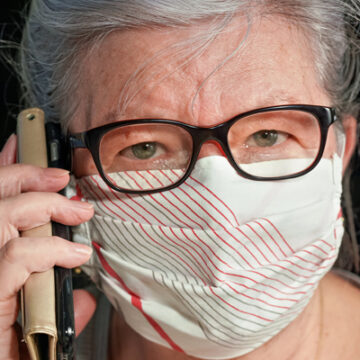Blog
Tips to Help People with Vision Loss Safely Practice Social Distancing During COVID-19

Social distancing and other guidelines related to COVID-19 present unique challenges – and possible safety hazards — for people who are blind or have vision loss. For example, signage or markers in supermarkets and pharmacies designed to help people maintain social distancing may not be readable or detectable to people with low vision.
Following are tips and suggestions to help you safely adhere to guidelines.
Outside the Home:
- Wear a mask. Put your mask on and adjust it before you leave your home. If you have low vision and wear glasses, try to make sure the mask is not causing your glasses to fog up before you leave the house. It is important not to touch the mask after you leave your home.
- Wear long sleeves to cover exposed skin
- Use the white cane. It’s advisable to use the cane for identification to heighten the awareness of others that you have a visual impairment. Using a cane in the current environment may help avoid confrontation and even provide the means for getting additional assistance.
- Speak up. If you think someone may be coming near you, speak up! The other person may not be mindful that you are approaching. When in public spaces announce your presence. Use verbal cues, such as: “Please let me know when I can move up in the line.” “My dog is not trained for social distancing, so please direct me, and I’ll direct him,” or “My apologies for coming so close, it’s very difficult to tell how far apart to be, so if you can move farther away, that would be great.”
- Keep your hand protected. If you need to use a sighted guide or touch something in the environment, be mindful of always using the same hand. You could put a latex glove on the non-cane hand and only use the hand with the glove on it to touch elevator buttons, doorknobs, etc. If you don’t want to use a glove and you need to use a handrail, carry a tissue with you to use as a barrier. Then put the tissue in zip lock bag to dispose of when you locate a garbage can.
- Navigate cautiously. Be extra aware of surroundings, and the presence of people who may be around. When possible, navigate at off-peak times when there are fewer crowds.
- Make provisions for safe transportation ahead of time, so it’s available in case of an emergency.
- Embrace technology. Applications such as Aira and Be My Eyes, and using phone cameras for magnification, can help you maintain social distancing and navigate in public areas.
In the Grocery Store
- Shop safely. Use delivery services whenever possible, or call ahead and place your order using a credit card and have someone bring you your package outside. If you need to go in to a store, shop during off-peak hours.
- Keep a safe distance. It’s helpful to remember that the recommended six feet distance is about the length of two full-size shopping carts.
- Ask a store employee to tell you where you should stand at the check-out counter.
- Encourage stores to be accessible. Stores and other businesses may not be aware that their COVID-19 signage is not readable by people with low vision. Encourage them to have large print, high contrast, and color-coded signage.
In the Home
- Ask visitors to wear a mask or face covering while they are in your home and you do the same.
- Provide sanitizer. If you have to have people come in from outside (home health aides, repair workers for emergencies, etc.), please provide hand sanitizer as they enter or ask them to wash their hands.
- Stay on track with your health by using telemedicine or telemental health services if you are not able to visit your healthcare professional’s office.
- Stay connected and active. Social distancing does not have to mean social isolation. Now maybe a good time to reconnect with old friends via phone or text. Consider joining a tele-support group so you can chat with others in a group setting via phone. Religious establishments, schools, and cultural organizations in your area may be offering accessible virtual services and eLearning. Consider learning a new skill, through classes currently being offered via phone or online. Listen to books you have been wanting to catch up on or perhaps complete a project around the house.
- Add structure and routine to your days. This can relieve a sense of helplessness, and provide a sense of accomplishment.
- Limit news. It is good to stay informed, however, information overload can be stressful.
- Exercise and stretch. Even a few minutes a day may make a difference.
You should note that what works for one person, may not work another and we are here to assist you through this difficult time. If you or someone you know need help, visit our COVID-10 Programs and Services page or call 800-284-4422.